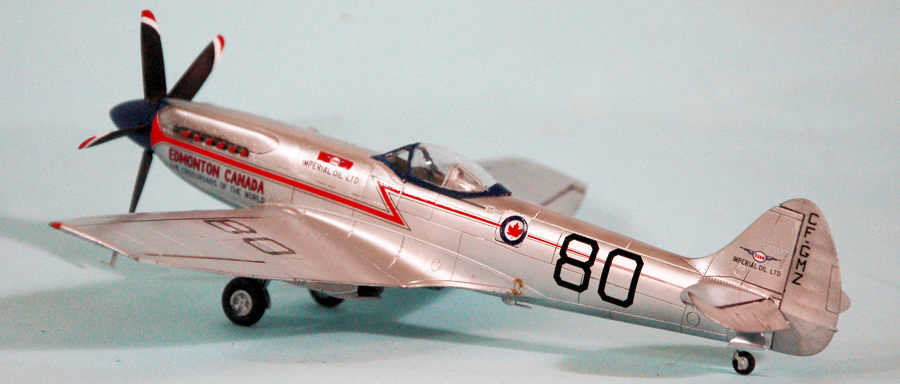
| KIT #: | 05135 |
| PRICE: | $29.95 |
| DECALS: | Two options |
| REVIEWER: | Tom Cleaver |
| NOTES: | Built as 'Race 80' |

| HISTORY |
Supermarine Spitfire FR XIVe TZ138 was delivered at Aldermaston on February 23, 1945 and sent to Rolls Royce at Hucknall for modification for cold weather testing. Prepared in June 1945 by No. 47 Maintenance Unit at Sealand, it was shipped to Canada aboard the S.S. Alder Province, arriving on November 11, 1945. After being transported to Edmonton, Alberta, by train,it was assembled and test flown, then assigned to Northwest Air Commandwhere it, along with other British and American aircraft, underwent cold weather testing while assigned to the Winter Experimental Establishment. It was displayed in Edmonton on May 5, 1946 and flew in the Calgary Airshow on July 9 after the engine was replaced in June at Ft. Nelson, B.C. It was grounded in Penhold while enroute to Winnipeg July 9-11. Further testing stopped in October and resumed in December 1946. Further trials began on January 13, 1947 and it was returned to Churchill, Manitoba on January 28, 1947.
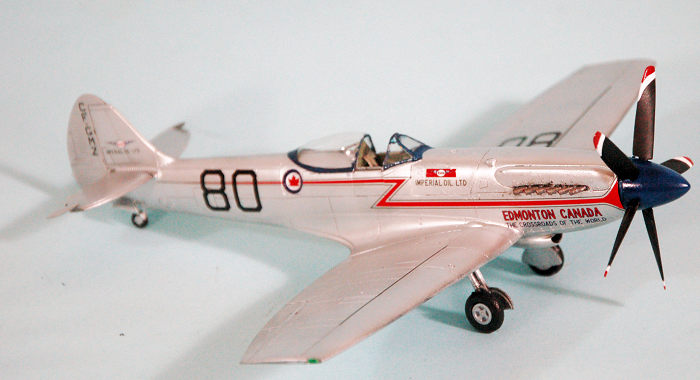 During
February 1947, while based at Churchill, TZ138 broke its composite/wood prop
landing at The Pas for fuel. A new prop was installed, but taxi and take off for
the narrow track Spit proved a serious problem, the fear being it would tip onto
its nose and damage the new prop. A set of de Havilland Tiger Moth skis were
modified with cradles for the Spit’s main gear and it was found that it could
taxi by using extra power. The normal Mk. XIV take off speed was too high and
set TZ138 bouncing, so it was determined that it would need to lift off at just
above stalling speed. On February 28, 1947, TZ138 took off successfully from The
Pas and flew to Churchill, becoming the only Spitfire to ever take off using
skis. The skis dropped away and were later recovered from a nearby snow covered
lake.
During
February 1947, while based at Churchill, TZ138 broke its composite/wood prop
landing at The Pas for fuel. A new prop was installed, but taxi and take off for
the narrow track Spit proved a serious problem, the fear being it would tip onto
its nose and damage the new prop. A set of de Havilland Tiger Moth skis were
modified with cradles for the Spit’s main gear and it was found that it could
taxi by using extra power. The normal Mk. XIV take off speed was too high and
set TZ138 bouncing, so it was determined that it would need to lift off at just
above stalling speed. On February 28, 1947, TZ138 took off successfully from The
Pas and flew to Churchill, becoming the only Spitfire to ever take off using
skis. The skis dropped away and were later recovered from a nearby snow covered
lake.
With cold
weather testing completed, TZ138 was struck off charge with 150.15 hours total
time on the clock and assigned to the War Assets Administration in Edmonton for
disposal. Ken Brown and Flight Lieutenant James McArthur (one of the Dambuster
pilots) bought it for $1250.00. The Spitfire received civilian registration
CF-GMZ on August 25, 1949 and a Department of Transportation certificate of
serviceability, approved for Class “F” racing. The Spitfire was then moved to
Edmonton, Alberta, where some of the locals remember it
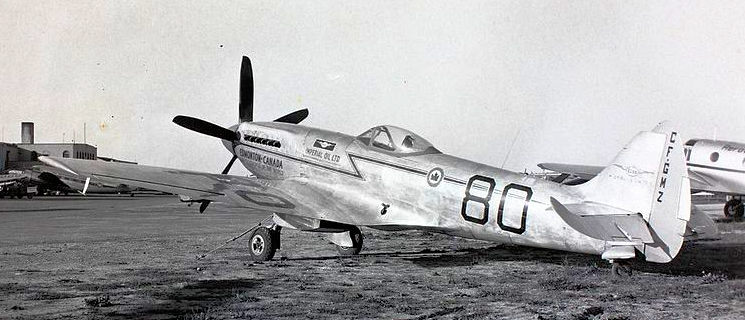 being stuck in the
corner of a hanger housing a local ice rink while it was turned into a racer
with the airframe stripped to natural metal and all unnecessary equipment
including the guns were removed. A new engine was installed, and with
sponsorship by Edmonton’s Imperial Oil Ltd., it was assigned race #80. It was to
be the first foreign- built aircraft to race in the National Air Races at
Cleveland since Michelle Detroyat flew the Caudron C.460 to victory in the 1935
Thompson Trophy race.
being stuck in the
corner of a hanger housing a local ice rink while it was turned into a racer
with the airframe stripped to natural metal and all unnecessary equipment
including the guns were removed. A new engine was installed, and with
sponsorship by Edmonton’s Imperial Oil Ltd., it was assigned race #80. It was to
be the first foreign- built aircraft to race in the National Air Races at
Cleveland since Michelle Detroyat flew the Caudron C.460 to victory in the 1935
Thompson Trophy race.
McArthur qualified #80 at 370.110 mph, good enough for the Tinnerman Trophy Race, but too slow for the Thompson. The 1949 Tinnerman included Ben McKillen flying the F2G-2 “Sohio #57,” Cook Cleland in F2G-2 #94, Wilson Newhall in P-51K #65, Anson Johnson in P-51D #45, James Hannon in P-51A #2, Jack Hardwick in P-38L #34, J.P. Hagerstrom in P-38L #14, H.S. Gidovlenko in P-38L #25, and mcArthur in Spitfire XIV “city of Edmonton” #80.
The race was flown on September 4, 1949, with a race horse start after which four of the competitors (Hannon, Cleland, Gidovlenko, Johnson) were forced to pull out. Ben McKillen’s winning F2G #57 took first place at 386.069 mph with Wilson Newhall’s second-place P-51K #65 at 379.735. McArthur’s 359.565 mph was good for third ahead of Jack Hardwick in P-38 #34 at 328.470 mph. McArthur won $1,050.
On
September 5, McArthur left Cleveland at 0600 hours with the winnings, without
announcing his destination, and flew the Spitfire to Miami, where it was sold to
Richard McNally’s I.B.A. Trading Corporation for $1000 on February 9, 1950.
Registered as N5505, it was sold December 14, 1951, to a company in Hollywood,
Florida, controlled by Cuban dictator Fulgencio Batista for $3,000. Batista’s
company applied to the State Department on January 25, 1952 to export TZ138 for
sale at a price of $7,500 in the Dominican Republic, which was likely a way to
get it to Cuba, which was under U.S. embargo for military equipment at the time.
The alleged “sale”
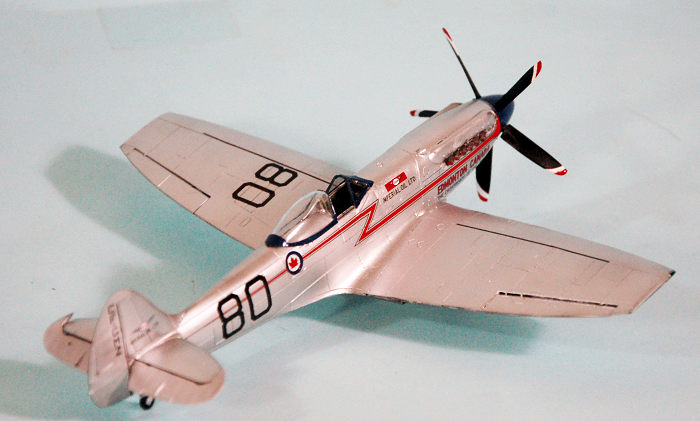 never happened, and the Spitfire was found with its propeller
sabotaged and the airplane abandoned at the Hollywood airport in June 1952,
where it was seized by U.S. Customs. Rumors abounded at the time that Cuban
opponents of the dictator (who may have been associated with Fidel Castro) were
the ones who sabotaged the propeller to prevent the sale. Since the title had
never been transferred, it was returned to the I.B.A. Trading Corporation, who
kept it until it was sold to Robert Geoffery of Orlando, Florida, January 6,
1958.
never happened, and the Spitfire was found with its propeller
sabotaged and the airplane abandoned at the Hollywood airport in June 1952,
where it was seized by U.S. Customs. Rumors abounded at the time that Cuban
opponents of the dictator (who may have been associated with Fidel Castro) were
the ones who sabotaged the propeller to prevent the sale. Since the title had
never been transferred, it was returned to the I.B.A. Trading Corporation, who
kept it until it was sold to Robert Geoffery of Orlando, Florida, January 6,
1958.
After that, “Race 80" had many owners, including three in Minnesota. During early 1960, it was listed with Lloyd Milner of Minneapolis. On February 22, 1960, it was with former racing pilot Lee Fairbrother of Rosemount, Minnesota. It was then sold to Charles H. Leidal of Fergus Falls, Minnesota on November 4, 1968 to be restored, which was completed in 1970. It’s first post-restoration flight was on March 2, 1979. In May 1970 it suffered a crash landing when the engine overheated due to a coolant hose rupture while Harlingen, Texas where it was to be operated by the then-Confederate (now Commemorative) Air Force. The forced landing damaged the right wing and crushed the radiator. During the 1970s it was sold to owners in Ontario; Colorado; Michigan; Connecticut; Florida; and Texas. In 1979-81 it was loaned to the Bradley Air Museum in Windsor Locks, Connecticut, registered as N138TZ. Afgter being sold to Kno Knapp of Fort Lauderdale, where it was reregistered as N5505A, it was sold to the Lone Star Flight Museum in Galveston in November 1988 and displayed in 1990-91, after which it was traded to noted air racer Bill "Tiger" Destefani of Bakersfield, who trucked it to California in January 1992. It was put into restoration by Liberty Aero Corporation on May 13, 1998, and was test-flown by noted warbird engineer and pilot Bruce Lockwood at Van Nuys, California on January 5, 1999. It was then sold to Robert Jens of Richmond, BC, on May 18, 2000 who registered it C-GSPT in a spurious “RAF camouflage scheme.” In 2006 it was donated to the British Columbia Institute of Technology in Vancouver, where it is displayed today.
| THE KIT |
Airfix’s Spitfire XIV is the first really accurate 1/48 Spitfire XIV released, and is clearly superior to the Academy kits issued 20-some years ago. The kit can be turned into the F.XIV, F.R. XIV or F.R. 18 without difficulty.
| CONSTRUCTION |
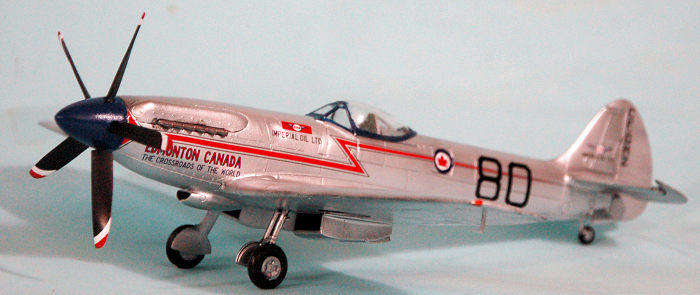 Several
modelers have complained about the difficulty of building the kit without use of
putty and with loss of detail. There is a very easy way to assemble this kit,
such that one will have perfect fit and will use no putty or other filler in the
process. Here it is:
Several
modelers have complained about the difficulty of building the kit without use of
putty and with loss of detail. There is a very easy way to assemble this kit,
such that one will have perfect fit and will use no putty or other filler in the
process. Here it is:
1. Before assembling the fuselage, glue some Evergreen strip inside along the lower join line for the gas tank. Assemble the fuselage without attaching the cockpit. This allows you to work the fit of the gas tank to the fuselage from inside and out to get a perfect fit. If you take care in attaching the fuselage halves, you will only have to scrape down the centerline joint to have a smooth result. Before attaching the fuselage halves, cut open the side hatch if you want to pose it open on the finished model.
2. Assemble the cockpit. Cut off the ferschlugginah “gun sight” and make a Mk.14 sight, which is easy since it’s a cube with an adjusting wheel on either side. All Spitfire XIVs used it and it solves the one “mistake” in the kit. (There are photos of the gunsight to be found on the net, google “photos of Mark 14 gyro gunsight”) I only used Eduard photo-etch seatbelts, the rest of the cockpit looks fine when it’s viewed inside the fuselage.
3. Insert the cockpit into the fuselage, it will “click” into position, then glue it in place.
4. Assemble the main gear wells to the lower wing part, then glue the lower wing to the fuselage.
5. Carefully make sure that the inner edge of the upper wing part will fit perfectly to the fuselage, smoothing off the sprue nubs. Attach the upper wing by starting with the wing-fuselage joint, then glue the upper part to the lower.
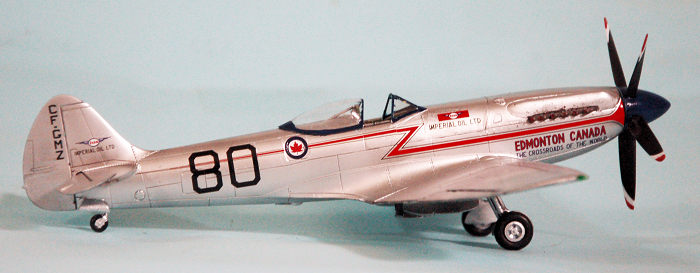 6. Attach
the horizontal stabilizer. Cut the elevators apart. Attach the plug in the
vertical fin, then attach the elevators as you wish them posed.
6. Attach
the horizontal stabilizer. Cut the elevators apart. Attach the plug in the
vertical fin, then attach the elevators as you wish them posed.
7. Assemble and attach the radiators and housings and the carburettor intake. If you flood the area where these parts will be attached with liquid glue, it will fill any gaps and you will not need putty anywhere.
You now have a perfectly-assembled model, ready for paint.
For this model, I took advantage of the fact that Airfix has “Race 80" in their sights for a future release, as evidenced by the scoring on the inside of the wings to allow a modeler to cut out the guns, and the wing leading edge plug on the sprue. I also filled the interior of the cannon cover bulges with C-A glue, then sanded them off the wing. I also sanded off the fairing under the cannons on the lower surface and filled in the shell ejection chutes. This Indian plastic is very soft and it took every scratch by the sanding sticks. After all that was done, I used several increasingly-fine sanding sticks and sanding pads, followed by a healthy dose of polishing, to restore the wing surfaces, after which I rescribed the panel lines. I decided to keep the cockpit flap up, to allow the stripe decal to go down the side unimpeded. It turns out, one can attach the canopy without gluing it if you do that, so you can slide it open or closed to display the cockpit as you feel fit. I kept the elevators and rudder off, since they would be painted differently. I attached the landing gear at this point because it would also be painted overall aluminum.
| COLORS & MARKINGS |
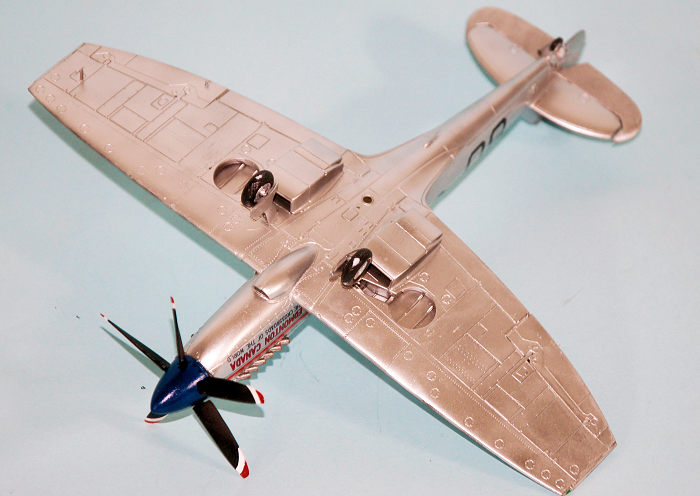 I gave the
model an overall primer coat of Tamiya Gloss Black, thinned 50-50 and “misted”
on until it gave proper color, to keep the surface as smooth as possible. I then
shot the model overall with Vallejo “Aluminum.” I used Vallejo “White Aluminum”
as the aluminum lacquer color for the fabric-covered tail control surfaces. The
spinner and the canopy framing was painted with Tamiya Gloss Blue X-4. I painted
the white tips of the propeller blade, masked them off, shot the prop black,
then hand-painted the red tips. It was important to have the surface as smooth
as possible and to apply the NMF aluminum perfectly, since there would not be a
lot of markings and such to distract the viewer of the completed model.
I gave the
model an overall primer coat of Tamiya Gloss Black, thinned 50-50 and “misted”
on until it gave proper color, to keep the surface as smooth as possible. I then
shot the model overall with Vallejo “Aluminum.” I used Vallejo “White Aluminum”
as the aluminum lacquer color for the fabric-covered tail control surfaces. The
spinner and the canopy framing was painted with Tamiya Gloss Blue X-4. I painted
the white tips of the propeller blade, masked them off, shot the prop black,
then hand-painted the red tips. It was important to have the surface as smooth
as possible and to apply the NMF aluminum perfectly, since there would not be a
lot of markings and such to distract the viewer of the completed model.
The decals came from the Academy “Special Release” Spitfire XIV kit that came out in 2005 that were printed by Cartograf. I’d kept those very interesting decals (Spitfires of the Belgian, Indian and Thai air forces in addition to “Race 80") over the years in hopes Airfix would finally do the intelligent thing and release a good Spitfire XIV, as they have now done. The “Race 80" decals went on without problem under a coat of Micro-Sol.
I assembled the prop and attached it, the main landing gear, and the exhaust stacks. I unmasked the canopy and put it in position; it slides back and forth without problem.
| CONCLUSIONS |
The bubble-top Spitfire XIV is the most “racery” looking Spitfire of all. If you put it on floats, it would definitely recall the S.6B Schneider Trophy racer that began the line. Doing it in one overall color, without weapons, brings out all the shapeliness of the Spitfire as the most beautiful single-seat piston-engine fighter ever built.
It’s pretty certain with everything Airfix includes in the kit, that modelers will be able to do “Race 80" in a future release. It’s easily one of the most elegant Spitfires of all.
22 August 2019
Copyright ModelingMadness.com
Review kit courtesy of my wallet.
If you would like your product reviewed fairly and fairly quickly, please contact the editor or see other details in the Note to Contributors.
Back to the Main Page Back to the Review Index Page Back to the Previews Index Page